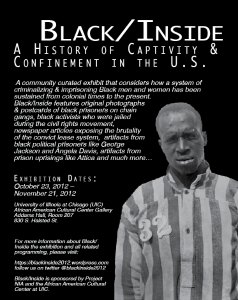
By Angelique Westerfield
Oct. 23 marked the opening of the latest exhibit featured at the African American Cultural Center on the campus of UIC. The exhibit entitled “Black Inside: Exploring History of Captivity and Confinement” consists of photographs depicting African Americans incarcerated. Dr. Lori Barcliff Baptista is the Director of the Cultural Center. She says that the exhibit helps opens dialogue on a major challenge African Americans have faced for centuries.
Billy Dee, Teresa Silva, and Mariam Kaba are the curators of “Black Inside.” The exhibit also features photographs from various prison camps, the incarceration of political prisoners such as Angela Davis and George Jackson, pictures of the infamous Scottsboro Boys case, and modern day cases of individuals wrongful convicted of crimes. Baptista points out the most striking element of the exhibit – a 6X9 jail cell constructed specifically for the exhibit. This is one of the only three-dimensional pieces that is part of the installation. However, all of the pieces are presented to promote dialogue, and encourage community participation in supplemental programming.
The AACC arranged guided tours for several school groups and community organizations. Baptista encourages public attendance to the theatrical performance scheduled for Nov. 7 at 7pm entitled, ‘Feeling Beautiful All Over.’ The group performing is Sister’s Rising – a theater ensemble comprised entirely of formerly incarcerated women. Their performance is based on their experiences as inmates, and an up close and personal view of the structural inequalities of the prison system as it relates to African-American women and men.
The theater performance not only offers the women of Sister’s Rising an opportunity to promote dialogue, but also offers a practical vehicle for employment. Baptista points out that job reentry is a real challenge for many former inmates. “If you have a record how do you work? How do you reintegrate in society? We hope to touch upon some of these major issues, themes, and concerns [in the exhibit]. We also hope to open a space for people to enter the conversation and not feel overwhelmed or hopeless. We can all approach these issues in different ways, because we are all impacted in different ways,” she adds.
January 2013 will be the 150th year of the Emancipation Proclamation. Baptista wants people to walk away from the exhibit questioning what the meaning of freedom. She notes, “It’s a complicated questions, but we need to really think about solutions. How can we get the root causes of the criminal system that leads to mass incarceration? If we de-criminalize certain offenses at a certain level can we lessen the incarceration rate?”
“Black Inside: Exploring History of Captivity and Confinement” exhibition runs through Nov. 21 at the African American Cultural Center at the University of Illinois at Chicago.
